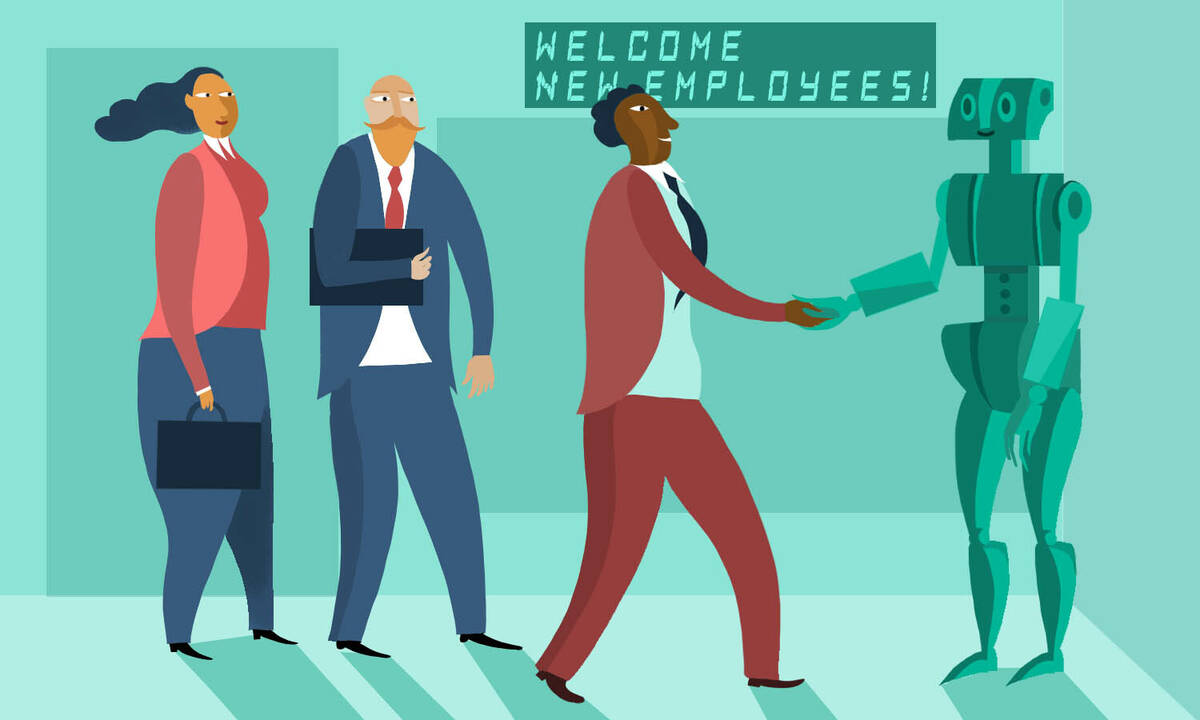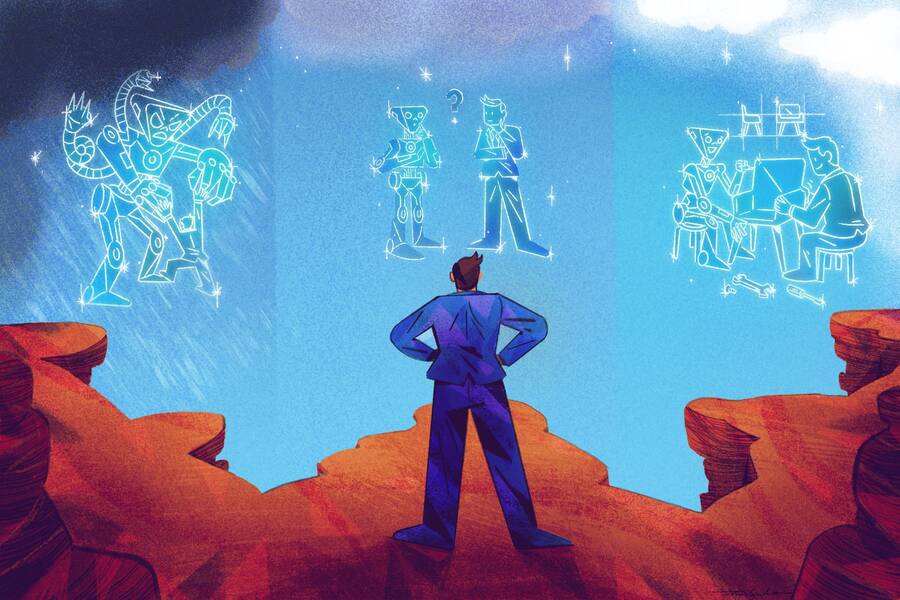So, what will these changes mean for the workers of tomorrow? Of course, no one has a crystal ball—but here are a few predictions, based on research by Kellogg faculty members.
Many of us are anxiously wondering whether and how much AI will change our jobs. And while the precise effects are difficult to predict, we can take lessons from the technological changes of the past.
Recent research by Dimitris Papanikolaou and Bryan Seegmiller (a professor and assistant professor of finance, respectively) examined how major innovations introduced between 1981 and 2016 affected workers and their earnings.
Papanikolaou, Seegmiller, and their colleagues focused on so-called breakthrough patents—those that were very different from previous patents but very influential on future patents. They were also careful to distinguish between tools that replace workers and those that complement workers.
The researchers found that when a new tool can perform a task in place of a worker, all affected workers suffer. “They experience a loss of wage earnings, and that is largely independent of age, their income level, which sector they’re working in, the type of job that they do, or whether they have a college degree,” Papanikolaou says. But when a new technology complements workers performing a task, the effects are more variable: the most experienced and highly paid workers suffer, while new hires appear to benefit.
The researchers also studied the potential ramifications of AI on today’s workers. “AI, as a technology, levels the playing field within an occupation,” Papanikolaou says. In other words, if everyone can code, a skilled and experienced coder will be less valuable in the job market. The upshot is that “it’s going to hurt workers that are better at their jobs.”
Four years since the start of the Covid-19 pandemic, many workers still find themselves logging on from home at least part of the time, and these geographically flexible workers report increases in productivity and satisfaction.
However, research by Hyejin Youn, an associate professor of management and organizations, finds that remote work does have downsides when it comes to on-the-job learning.
In analyzing more than 17 million scientific publications over the past 45 years, Youn and her coauthor found that researchers who collaborated locally were much more likely to gain new knowledge from their teammates than those who collaborated at a distance. The trend was especially pronounced for researchers in science and engineering, as well as early-career scholars.
To Youn, these findings suggest that being together physically—reading body language, mulling a problem at a whiteboard, and teaming up to use specialized laboratory equipment—is especially valuable when knowledge isn’t yet codified.
Of course, that doesn’t mean remote work needs to go by the wayside. Youn suggests companies should find the right blend of having employees work from home, where they can be productive, and bringing them into the office, where they can work together to create new knowledge; firms focused on innovation should be particularly careful to find the right balance.
“Bring people together so they can exchange ideas in person,” she says. “We are incredibly good at learning from each other, especially in these murky ways that can lead to innovation.”
So, what about those times when workers aren’t in the office together, learning from one another? If the past decade is any indication, some adventurous souls will head abroad. Popular global cities, including Paris and Venice, have seen a surge of foreign arrivals from wealthy countries, laptops in hand and stars in their eyes, settling in for months or longer.
Among locals, reactions are mixed. Affluent foreigners patronize local stores and restaurants, but bring with them increases in rents, traffic, and congestion, as well as cultural changes. For governments, figuring out how to balance these costs and benefits is tricky.
Some countries, convinced the good is worth the bad, have actively encouraged foreigners with housing subsidies; others have taken the opposite approach, outright restricting would-be expats from buying homes or heavily taxing their property purchases. But which strategy is best?
Neither, according to research by Sergio Rebelo, a professor of finance. With his colleagues, Rebelo developed a mathematical model to test different policy approaches. They identified a kind of Goldilocks solution: tax capital gains on property sales for everyone and use the revenue to help offset the harms caused to locals. This tax-and-transfer approach provides “a win–win solution,” Rebelo says.
The research also highlights some long-term approaches that countries can take as they adjust to their new realities. In Paris, for instance, some companies moved their offices to outlying districts, making way for tourists and other foreigners in central districts. It’s a different city—but that’s not necessarily a bad thing. After all, Rebelo says, “cities are like a living organism, and they transform organically over time.”
When extreme floods, wildfires, or droughts hit a region, the labor market in that area will naturally be affected. For instance, if unusually dry weather ruins a local crop, farm employees may be forced to find new jobs.
But research by Jacopo Ponticelli, an associate professor of finance, shows that the economic effects of extreme weather persist well beyond the immediate aftermath, as workers migrate to other areas—and the flow of capital follows them.
In a study of data from Brazil, Ponticelli and his colleagues found that areas experiencing unusual dryness suffered sharp declines in farm productivity and employment. In the short term, loans were directed toward the affected regions. But when dry conditions persisted for a decade, that financial stream dwindled, either because people were leaving or banks were lending less money.
Many workers in these newly arid regions moved, often to urban centers. But the transitions didn’t always go smoothly, the researchers found. While some migrants got new jobs in agriculture or the service industry, they struggled to break into the manufacturing sector, perhaps because they lacked social connections or skills.
Ponticelli argues that policymakers will need to do more to help displaced workers find employment, since such migrations will likely only intensify in the future. “These climate shocks generate a lot of reallocation of labor,” Ponticelli says. “If we go toward drier and drier conditions in these areas, which is what all the climate models predict, we’re going to see even more of this reallocation.”
If you’ve used a digital platform, there’s a good chance you’ve also been an experimental subject. Platforms like Uber and LinkedIn typically have thousands of tests running at any given time. And it’s not just customers who have become unwitting guinea pigs; it’s also the millions of people who rely on these apps for gig work.
Hatim Rahman, an assistant professor of management and organizations, wanted to understand how this status quo came to be and what it might mean for workers in the future.
To answer that question, Rahman and his colleagues used data from QuickHire, a pseudonym for one of the world’s largest digital labor platforms. They discovered that between 2004 and 2020, QuickHire moved through three “experimentation regimes.” At first, experimentation was explicit and conducted only on those who had voluntarily opted into it; in the second stage, experimentation became concealed, with workers participating in studies without their notification or consent; and in the final stage, experimentation was unbounded, with many experiments running simultaneously and continuously.
Rahman and his colleagues were surprised by how workers met this final stage: without pushing back or leaving the platform en masse. “Rather than observing collective worker exit, we found workers responded with resigned acceptance,” the researchers wrote.
Still, organizations do themselves a disservice by failing to account for the long-term impacts of concealed and unbounded experimentation, Rahman argues. For one thing, the integrity of experiments themselves can be undermined by jaded participants who expect any small change they see to be part of some larger test. Experiments can also pose a challenge to morale.
That doesn’t mean platforms need to do away with experimentation altogether. Rather, the researchers propose, they should take steps to make such tests more transparent and accountable. For example, organizations can form internal boards—or independent, external oversight units—to oversee experimentation and ensure helpful, insightful outcomes for both leaders and workers.




